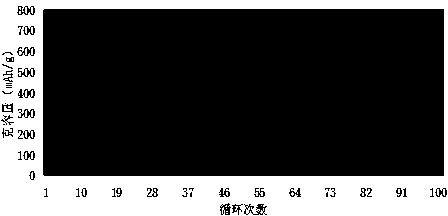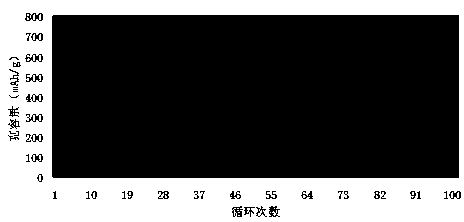Preparation method of high-volume silicon-carbon negative electrode material
A negative electrode material, high-capacity technology, applied in battery electrodes, structural parts, graphite, etc., can solve the problems of large irreversible capacity, high volatile content, affecting the electrical properties of materials, etc., to ensure cycle stability and strong corrosion resistance. , to ensure the effect of stable performance
- Summary
- Abstract
- Description
- Claims
- Application Information
AI Technical Summary
Problems solved by technology
Method used
Image
Examples
Embodiment 1
[0035] Add mesophase pitch (softening point 250°C) and phenolic resin (softening point 110°C) into a 20L kneading kettle at a ratio of 1:3 (3.5Kg and 10.5Kg), start heating up to 300°C, and then After the asphalt and resin are both melted into liquid, add 0.315Kg of curing agent—hexamethylenetetramine according to the proportion of 3% of the resin weight, and keep stirring until all components are mixed evenly; according to the total weight of asphalt and resin: silicon powder: The weight of the dispersion solvent is 1:0.1:0.3. Weigh 1.4Kg of silicon powder with an average particle size of 50nm and 5.2 kg of alcohol solution. After adding the silicon powder to the alcohol solution, disperse it through an ultrasonic device. , add to the mixed liquid of asphalt, resin and curing agent that has been mixed evenly, stir for 120 minutes, spray and cool through the ultrasonic atomization device, and collect the powder with an average particle size between 5 and 45 μm through the cyclo...
Embodiment 2
[0038] Add mesophase pitch (softening point 250°C) and phenolic resin (softening point 110°C) into a 20L kneading kettle at a ratio of 1:4 (3Kg and 12Kg), and start heating up to 300°C. After the resin is melted into a liquid, add 0.48Kg of curing agent-hexamethylenetetramine according to the proportion of 4% of the resin weight, and keep stirring until all components are mixed evenly; according to the total weight of asphalt and resin: silicon powder: dispersing solvent The weight is 1:0.09:0.27. Weigh 1.35Kg of silicon powder with an average particle size of 50nm and 4.05 kg of xylene solution. After adding the silicon powder to the xylene solution, disperse it through an ultrasonic device. , add the mixed liquid of asphalt, resin and curing agent that has been mixed evenly, stir for 150 minutes, spray and cool through the centrifugal atomization device, and collect the powder with an average particle size between 5 and 45 μm through the cyclone separator, and then in the He...
PUM
| Property | Measurement | Unit |
|---|---|---|
| softening point | aaaaa | aaaaa |
| particle size | aaaaa | aaaaa |
| softening point | aaaaa | aaaaa |
Abstract
Description
Claims
Application Information
 Login to View More
Login to View More - R&D
- Intellectual Property
- Life Sciences
- Materials
- Tech Scout
- Unparalleled Data Quality
- Higher Quality Content
- 60% Fewer Hallucinations
Browse by: Latest US Patents, China's latest patents, Technical Efficacy Thesaurus, Application Domain, Technology Topic, Popular Technical Reports.
© 2025 PatSnap. All rights reserved.Legal|Privacy policy|Modern Slavery Act Transparency Statement|Sitemap|About US| Contact US: help@patsnap.com


